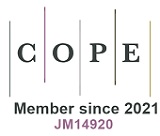Raman-Enhanced Spectroscopy (RESpect) Probe for Childhood Non-Hodgkin Lymphoma
Downloads
Raman-enhanced spectroscopy (RESpect) probe, which enhances Raman spectroscopy technology through a portable fiber-optic device, characterizes tissues and cells by identifying molecular chemical composition showing distinct differences/similarities for potential tumor markers or diagnosis. In a feasibility study with the ultimate objective to translate the technology to the clinic, a panel of pediatric non-Hodgkin lymphoma tissues and non-malignant specimens had RS analyses compared between standard Raman spectroscopy microscope instrument and RESpect probe. Cryopreserved tissues were mounted on front-coated aluminum mirror slides and analyzed by standard Raman spectroscopy and RESpect probe. Principal Component Analysis revealed similarities between non-Hodgkin lymphoma subtypes but not follicular hyperplasia. Standard Raman spectroscopy and RESpect probe fingerprint comparisons demonstrated comparable primary peaks. Raman spectroscopic fingerprints and peaks of pediatric non-Hodgkin lymphoma subtypes and follicular hyperplasia provided novel avenues to pursue diagnostic approaches and identify potential new therapeutic targets. The information could inform new insights into molecular cellular pathogenesis. Translating Raman spectroscopy technology by using the RESpect probe as a potential point-of-care screening instrument has the potential to change the paradigm of screening for cancer as an initial step to determine when a definitive tissue biopsy would be necessary.
Downloads
Lee, S., Day, N. S., Miles, R. R., Perkins, S. L., Lim, M. S., Ayello, J., ... & Cairo, M. S. (2017). Comparative genomic expression signatures of signal transduction pathways and targets in paediatric Burkitt lymphoma: a Children's Oncology Group report. British journal of haematology, 177(4), 601-611. doi:10.1111/bjh.14604.
Austin, L. A., Osseiran, S., & Evans, C. L. (2016). Raman technologies in cancer diagnostics. The Analyst, 141(2), 476–503. doi:10.1039/c5an01786f.
Çulha, M. (2015). Raman spectroscopy for cancer diagnosis: how far have we come? Bioanalysis, 7(21), 2813–2824. doi:10.4155/bio.15.190
Chan, J. W., Taylor, D. S., Zwerdling, T., Lane, S. M., Ihara, K., & Huser, T. (2006). Micro-Raman Spectroscopy Detects Individual Neoplastic and Normal Hematopoietic Cells. Biophysical Journal, 90(2), 648–656. doi:10.1529/biophysj.105.066761
Das, D. K. (2004). Fine-needle aspiration (FNA) cytology diagnosis of small round cell tumors: value and limitations. Indian journal of pathology & microbiology, 47(3), 309-318.
Smith, M. B., Katz, R., Thomas Black, C., Cangir, A., & Andrassy, R. J. (1993). A rational approach to the use of fine-needle aspiration biopsy in the evaluation of primary and recurrent neoplasms in children. Journal of Pediatric Surgery, 28(10), 1245–1247. doi:10.1016/s0022-3468(05)80306-9.
Shiramizu, B., Oda, R., Kamada, N., Garcia, M. A., Shieh, T., Maeda, T. A., ... & Misra, A. (2018). Unique Raman spectroscopic fingerprints of B-cell non-Hodgkin lymphoma: Implications for diagnosis, prognosis and new therapies. Journal of biological and medical sciences, 2(1).
Kamemoto, L. E., Misra, A. K., Sharma, S. K., Goodman, M. T., Luk, H., Dykes, A. C., & Acosta, T. (2010). Near-infrared micro-Raman spectroscopy for in vitro detection of cervical cancer. Applied spectroscopy, 64(3), 255-261.
Sharma, S. K., Kamemoto, L. E., Misra, A. K., Goodman, M. T., Luk, H. W., & Killeen, J. L. (2010). In-vitro micro-Raman study of tissue samples for detecting cervical and ovarian cancer with 785-nm laser excitation. Smart Biomedical and Physiological Sensor Technologies VII. doi:10.1117/12.849613.
Butler, H. J., Ashton, L., Bird, B., Cinque, G., Curtis, K., Dorney, J., … Martin, F. L. (2016). Using Raman spectroscopy to characterize biological materials. Nature Protocols, 11(4), 664–687. doi:10.1038/nprot.2016.036.
De Luca, A., Dholakia, K., & Mazilu, M. (2015). Modulated Raman Spectroscopy for Enhanced Cancer Diagnosis at the Cellular Level. Sensors, 15(6), 13680–13704. doi:10.3390/s150613680.
Pramanik, A., Chavva, S. R., Viraka Nellore, B. P., May, K., Matthew, T., Jones, S., … Ray, P. C. (2017). Development of a SERS Probe for Selective Detection of Healthy Prostate and Malignant Prostate Cancer Cells Using ZnII. Chemistry - An Asian Journal, 12(6), 665–672. doi:10.1002/asia.201601685.
Sharma, M., Marple, E., Reichenberg, J., & Tunnell, J. W. (2014). Design and characterization of a novel multimodal fiber-optic probe and spectroscopy system for skin cancer applications. Review of Scientific Instruments, 85(8), 083101. doi:10.1063/1.4890199.
Jermyn, M., Mercier, J., Aubertin, K., Desroches, J., Urmey, K., Karamchandiani, J., … Petrecca, K. (2017). Highly Accurate Detection of Cancer In Situ with Intraoperative, Label-Free, Multimodal Optical Spectroscopy. Cancer Research, 77(14), 3942–3950. doi:10.1158/0008-5472.can-17-0668.
Misra, A. K., Sharma, S. K., Kamemoto, L., Zinin, P. V., Yu, Q., Hu, N., & Melnick, L. (2009). Novel micro-cavity substrates for improving the Raman signal from submicrometer size materials. Applied spectroscopy, 63(3), 373-377.
Boelens, H. F. M., Dijkstra, R. J., Eilers, P. H. C., Fitzpatrick, F., & Westerhuis, J. A. (2004). New background correction method for liquid chromatography with diode array detection, infrared spectroscopic detection and Raman spectroscopic detection. Journal of Chromatography A, 1057(1-2), 21–30. doi:10.1016/j.chroma.2004.09.035.
Jolliffe IT. Principal Component Analysis. New York, NY: Springer, 2002.
Pisick, E., Skarin, A. T., & Salgia, R. (2003). Recent advances in the molecular biology, diagnosis and novel therapies for various small blue cell tumors. Anticancer research, 23(4), 3379-3396.
Mahadevan-Jansen, A. (1996). Raman spectroscopy for the detection of cancers and precancers. Journal of Biomedical Optics, 1(1), 31-70. doi:10.1117/12.227815 1.
Richards-Kortum, R., & Sevick-Muraca, E. (1996). Quantitative Optical Spectroscopy for Tissue Diagnosis. Annual Review of Physical Chemistry, 47(1), 555–606. doi:10.1146/annurev.physchem.47.1.555
Krafft, C., Steiner, G., Beleites, C., & Salzer, R. (2009). Disease recognition by infrared and Raman spectroscopy. Journal of Biophotonics, 2(1-2), 13–28. doi:10.1002/jbio.200810024.
- This work (including HTML and PDF Files) is licensed under a Creative Commons Attribution 4.0 International License.












